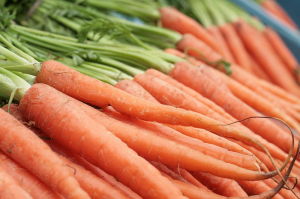
Our skin will be turning orange soon: we have consumed so many fresh garden carrots in the last two weeks.
Carrot harvesting season is comforting for me. While digging, topping, washing, trimming, drying, and bagging carrots consume many hours, there’s comfort in knowing we’ll have garden carrots at least until Christmas.
It has also been fun sharing our bounty with those of our friends who really appreciate carrots from the garden.
Carrots are relatively easy to grow in our short growing season, especially since they can tolerate freezing temperatures well into fall. Their requirements include, fertile soil without lumps, regular rainwater, and weeding once or twice before the carrots take hold. After that, one can pretty much forget them unless it’s to do some thinning. I tend to not bother. I simply begin harvesting the bigger ones early in the season, which leaves room for the remaining roots to grow.
A carrot from the garden is a different animal from anything one can buy in the grocery stores or even the farmer’s markets. They have a subtle sweetness and as teeth grind the crunchy flesh one can taste the succulent natural sugars bursting from the juice.
There are many good reasons to eat carrots for health. One serving (one large carrot)contains more than the Recommended Daily Allowance for Vitamin A (betacarotene). They are known to contain phytonutrients and other antioxidants like Vitamin C.
They are low in calories; one cup has about 50 calories. While they do have sugar, their total carbohydrates are only about 5% of calories. They are low on the glycemic index, likely because of their fibre.
One thing that always bothered me about the Atkins Diet is the vilification of carrots. “They’re too high in sugar” people tell me. Nonsense! Calories and carbohydrates are not the only reasons to eat a food. Nutrient density should be the goal. Carrots should be eaten with gusto, given their stellar nutritional profile. In-depth nutritional analysis here: http://www.whfoods.com/genpage.php?tname=nutrientprofile&dbid=76
Carrots are versatile. I use them as a base for many dishes, along with onions, celery and garlic. From there, I make stir fries, soups and stews. Carrots can be eaten raw with dips, in salads and slaws, and even in desserts. I’ve used pureed carrot in lieu of pumpkin in pies for decades and nobody knows the difference unless I tell them. That was especially fun with my father and sister who both claim to dislike carrots. They couldn’t believe they were eating carrots.
Plan to plant some carrots next spring, even in pots or in a small bed near your home’s foundation. You will reap the rewards for much of the summer and into fall.
To help you consume your bounty of carrots, check out these three recipes.
Learn more abut carrots: http://www.whfoods.com/genpage.php?tname=foodspice&dbid=21



